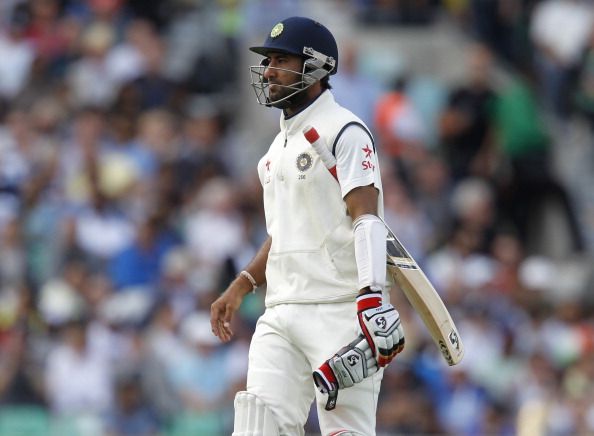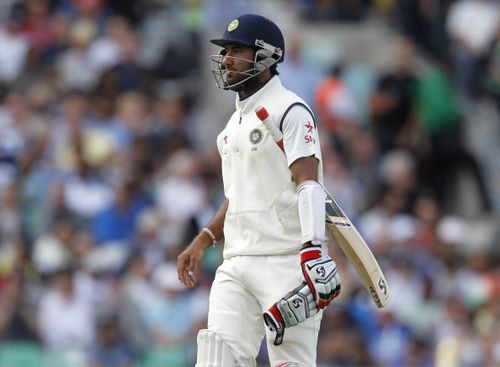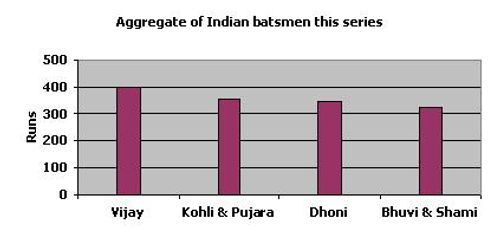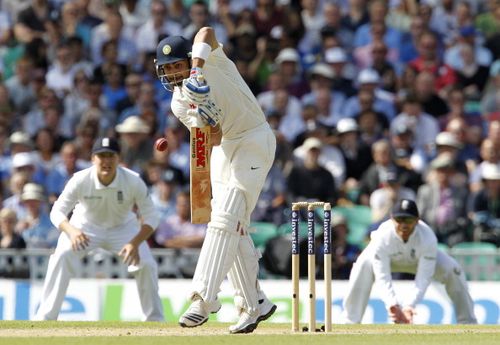
England v India 2014: Dissecting Cheteshwar Pujara and Virat Kohli's struggles

As Cheteshwar Pujara gestured towards the umpire while taking middle stump guard for the last time in this tour, he found himself in an unfamiliar predicament: not that the opening combination has failed for the first time exposing him to the swing and pace within the first five overs, but that the result of the match, and consequently the series, had already been scripted.
The prolific run-scorer from Saurashtra, often touted as the bulwark of the Indian batting for the next decade, faced an alien quandary. None in the realm of optimism expected him to persevere and eek out a survival against heavily stacked odds. Pujara, for the first time in his brief international career, found himself helpless against the fateful cascade of inevitability.
Yet he tried his best to defy his fate. He blocked, shouldered his arms, drove on the front foot and finally yielded to a James Anderson-delivery that held its line inches outside off. Playing for the incoming delivery, ironically, spelt his doom. The nervousness regarding the inswinger that had ripped him apart throughout the series finally came to an end with almost poetic justice.
Pujara’s misery at No. 3
The agony had begun for Pujara after his gritty half-century in the second innings at Trent Bridge. Since then, he has only managed 129 runs in eight innings, a stretch of run that also witnessed his first international duck. The embarrassment quotient escalated as the series progressed with scores of 24, 2, 0, 17, 4 and 11 in the last three Tests.
So, how do you explain the undoing of Pujara? First things first. Stuart Broad and Anderson, along with the other England bowlers, deserve their fair share of credit for mincing the Indian batting line up into shreds. They bowled neatly with flawless skill and control and exposed the vulnerabilities of each and every batsman with incisive deliveries.
Having said that, it has been the lack of application and technical imperfections on part of the Indians that have made the Jimmy Andersons appear so impressive. Pujara’s case, however, has been slightly different. More than technical glitches, it has been his approach and shot selection that have betrayed him even after promising starts.
Failure to live up to his talents
With a temperament and technique that suits Test cricket at its highest level, Pujara had showcased his appetite for big scores during his 153 in Johannesburg and a masterful 70 in Durban. But cricket, as they say, is the ultimate leveler. The law of averages caught up with him as the collapse that initiated in New Zealand continued throughout this series.
Exposure to the new ball too early in the innings in conditions difficult for batting has, of course, been a major factor. Both Shikhar Dhawan and Gautam Gambhir – even Murali Vijay to an extent – have continuously failed to survive the first hour of play and nullify the seam and swing. Pujara, therefore, had been forced to walk out as a virtual opener more often than he would have preferred.
Mode of dismissals
The dismissals throughout the series have been fairly – and unnervingly – regular. The rapid fall of wickets at the other end, courtesy the top order’s off form, would build up pressure, and Pujara would inevitably succumb to it by reaching out audaciously and playing away from the body. For a defensively correct cricketer like him, this propensity of getting overwhelmed with anxiety has got to do with issues that are more mental than technical.
The foot movement, quite strangely, has often been tentative on Pujara’s part and that, no doubt, has resulted in fatalities on a regular basis. In seaming and swinging English conditions, having your feet rooted to the ground is akin to taking guard with eight stumps.
Although this would generally be regarded as a practical flaw that demands elementary tutoring, for a technically sound batsman as is in our case, it’s evidently nothing more than a psychological block. A couple of pep talks from batting legends like Rahul Dravid and Sourav Ganguly must be enough to clear it and help him adjust to different situations in the game.
Virat Kohli’s ceaseless struggles

Along with Pujara, Virat Kohli has been one of the major disappointments of India in this tour of England. Considered as the one chosen to carry on the legacy of Sachin Tendulkar, Kohli’s England debut had had to bear the expectations of a majority of Indians. As he began his march towards the pavilion after edging one to the slips, he remained unaware of what lay ahead of him.
The next four innings saw him score a collective 34 runs including a duck. He managed a few elegant strokes en route to his 39 at the Ageas Rose Bowl before throwing his wicket away in an ostensibly outrageous fashion. The crowd ‘ooh’ed and ‘aah’ed, yet none attempted to scrutinize his recurrent failures, passing it off as merely a rough patch in a promising career.
The concern surfaced only when Kohli returned with a second duck in the first innings at Old Trafford. Pundits and analysts finally stumbled upon what Alastair Cook’s men had already spotted in the first Test. By then, destiny had already been written down, and Kohli’s next three innings of 7, 6 and 20 were already waiting to brace formality.
The chink in the armor

Unlike Pujara, the fracture in Kohli’s technical armor was glaringly evident. Apart from a couple of instances, he has chiefly found his death knell in the slips or behind the wicket. The uncertainty surrounding the off stump has effected in frequent indecision with deadly outcomes every time.
Struggling to counter length deliveries that swung both ways, Kohli resorted to punching at everything in the line of fourth and fifth stump. Broad and Anderson were content to feed him with as many as 90 per cent of their deliveries missing the stumps and hope for an induced edge. To their ecstasy, Kohli kept the face of the bat open and played away from the body so much so that, by the fifth Test, Anderson had dismissed him four times in 35 balls.
In his ten innings this series, Kohli has aggregated 134 runs at a dismal average of 13.40. His foot movement has been erratic; he has moved too far across too often and has repeatedly failed to get in the line of the ball. Commentary analysis suggested that his front foot had a tendency to move down the pitch, instead of towards the ball, resulting in a position from where he was unable to leave what demanded to be left.
These are, of course, technical defects that require proper adjustments. The absurd comparisons with Tendulkar and the pressure of delivering every time he goes out at No. 4 may have caused a psychological stress, but that is no excuse for getting dismissed in an identical fashion right through a five-match Test series.
Shastri and Bhogle’s suggestions
During India’s collapse in the recently concluded Oval Test, Ravi Shastri and Harsha Bhogle had scooped up an interesting suggestion. Considering Ajinkya Rahane’s relatively better form, they spoke about sending him ahead of Kohli at No. 4, thereby shielding the Delhi batsman from Anderson’s wrath.
Shuffling the batting order, especially one that is presently in the process of settling down, may not seem to be a lucrative idea at the onset, but, then again, it would only be a temporary measure, and not a permanent solution. There’s certainly no harm in protecting the two best batsmen in the team when they are simultaneously going through a difficult phase.
MS Dhoni, as was evident, decided against improvisation in the second innings sending Pujara out at one down, followed by Kohli. Unsurprisingly, both failed to deliver and so did the rest of the team as England managed to impose a handsome victory by an innings and 244 runs.
The unflattering form of the batsmen along with their vulnerabilities in bowler-friendly conditions has cost India dearly in this tour. However, this young squad is still on the learning curve, and the experience from a series defeat may actually aid their preparations for the next big tour against Australia. As for the positives, the drawn Test at Trent Bridge and the historic Lord’s win are sure to provide them motivation and confidence to return to the nets and iron out their glitches.